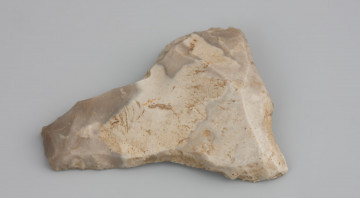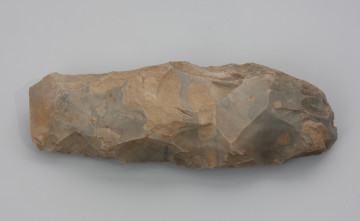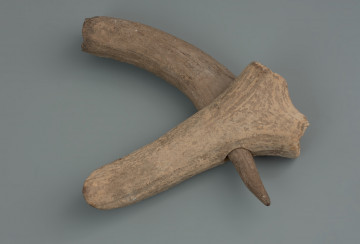
Flake axe
9600 p.n.e. — 9000 p.n.e.
National Museum in Szczecin
Part of the collection: Stone Age
In the late 1930s, amateur archaeological research was conducted near the village of Groß Jestin, now Gościo, located in the district of Kołobrzeg. Finds there included artefacts of the Paleolithic Ahrensburg culture and the Maglemose culture of the Middle Mesolithic period, including the presented core axe. It was made on a massive flake, as evidenced by a section of the underside of the stone flake forming one of the sides of the core axe. The piece was probably initially slightly more prominent, as suggested by the traces of repairs observed around the working part. This, together with the intense gloss visible at the butt, which formed as a result of flaying, suggests that the tool, dated to between 7800 and 7000 BC, was used for a relatively long time by the people of the Maglemose culture. The artefact has not been subjected to traceological examination, so its exact function is unknown. It is likely that, like most core axes, it was used for a whole range of heavy work involving woodworking, bone work, antler work, splitting animal carcasses, punching air holes, or digging. Core axes were used as working elements in composite tools, the design of which facilitated the quick replacement of individual components depending on the task at hand or complete disassembly of the device, e.g., for transportation. Michał Adamczyk
Author / creator
Object type
axe (mesolithic tool)
Technique
hard-hammer knapping
Material
chalk flint
Origin / acquisition method
acquisition
Creation time / dating
Creation / finding place
Owner
Muzeum Narodowe w Szczecinie (1945- )
Identification number
Location / status

9600 p.n.e. — 9000 p.n.e.
National Museum in Szczecin

7000 p.n.e. — 4100 p.n.e.
National Museum in Szczecin

9600 p.n.e. — 5400 p.n.e.
National Museum in Szczecin
DISCOVER this TOPIC
National Museum in Szczecin
DISCOVER this PATH
Educational path